Navy Art
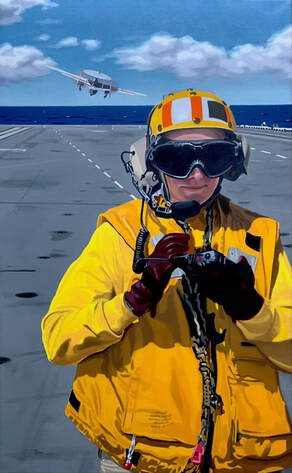
ABHCS Ashton Hemphill
26x16 Oil on Linen
On 15 September 2023 I was fortunate to arrive via a C-2 as a visitor for about 24 hours aboard USS George Washington off the coast of Florida. It was my first time aboard a Navy vessel at sea and it was quite an education. Part of the visit was a tour of the flight deck during air operations. A handful of E-2D Hawkeyes were already in the ship’s flight pattern with students with VAW-120 from Naval Station Norfolk working to get their initial carrier qualification. Our tour of the flight deck was conducted by ABHCS Ashton Hemphill, who did a great job of keeping us away from turning props and from being blown over by the combination of wind, the ship’s speed and prop wash from the Hawkeye just launched from catapult one. The ship was pitching and rolling quite a bit from the large swells from Hurricane Lee out at sea northeast of Norfolk. ABHCS Hemphill hails from Westminster, Maryland. She absolutely love’s her Navy job and is a sixteen-year veteran of the Navy having served aboard USS Ronald Reagan, NATTC Pensacola, USS Abraham Lincoln and Senior Enlisted Leader at USNA before joining USS George Washington. She has earned a bachelor’s degree in criminal justice and is nearing completion of a master’s degree in project management. One of her favorite sayings is “Feel the deck, be the deck.”
26x16 Oil on Linen
On 15 September 2023 I was fortunate to arrive via a C-2 as a visitor for about 24 hours aboard USS George Washington off the coast of Florida. It was my first time aboard a Navy vessel at sea and it was quite an education. Part of the visit was a tour of the flight deck during air operations. A handful of E-2D Hawkeyes were already in the ship’s flight pattern with students with VAW-120 from Naval Station Norfolk working to get their initial carrier qualification. Our tour of the flight deck was conducted by ABHCS Ashton Hemphill, who did a great job of keeping us away from turning props and from being blown over by the combination of wind, the ship’s speed and prop wash from the Hawkeye just launched from catapult one. The ship was pitching and rolling quite a bit from the large swells from Hurricane Lee out at sea northeast of Norfolk. ABHCS Hemphill hails from Westminster, Maryland. She absolutely love’s her Navy job and is a sixteen-year veteran of the Navy having served aboard USS Ronald Reagan, NATTC Pensacola, USS Abraham Lincoln and Senior Enlisted Leader at USNA before joining USS George Washington. She has earned a bachelor’s degree in criminal justice and is nearing completion of a master’s degree in project management. One of her favorite sayings is “Feel the deck, be the deck.”
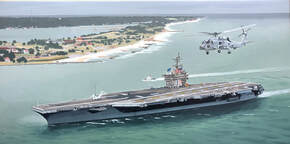
George Washington Returning from Sea Trials
15x30 oil on Linen
This was the scene on 25 May 2023 as the Nimitz-class carrier USS George Washington (CVN 73) returned to NS Norfolk from sea trials after its mid-life refueling and complex overhaul. The sea trials are a comprehensive test of the ship’s systems and technologies following the overhaul. The SH-60R helicopter is a nod to pilot CAPT Brent Gaut, who was also CO of the George Washington at the time. The reference photo for this painting was taken by Mass Communications Specialist 3rd Class Nicholas A. Russell.
15x30 oil on Linen
This was the scene on 25 May 2023 as the Nimitz-class carrier USS George Washington (CVN 73) returned to NS Norfolk from sea trials after its mid-life refueling and complex overhaul. The sea trials are a comprehensive test of the ship’s systems and technologies following the overhaul. The SH-60R helicopter is a nod to pilot CAPT Brent Gaut, who was also CO of the George Washington at the time. The reference photo for this painting was taken by Mass Communications Specialist 3rd Class Nicholas A. Russell.
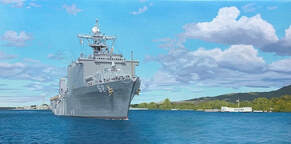
USS Pearl Harbor
15x30 Oil on Linen
USS Pearl Harbor (LSD-52) is a Harpers Ferry-class dock landing ship. It is named after the attack on Pearl Harbor on December 7th, 1941. The name Pearl Harbor was awarded on October 12th, 1993, and the ship was laid down on January 27th, 1995 in Avondale Shipyards, New Orleans, LA. She was launched on February 24, 1996 and officially commissioned on May 30th, 1998. The Pearl Harbor is currently stationed out of Naval Station San Diego, California. Depicted here, the Pearl Harbor has just secured from honoring the memory of those lost on the battleship USS Arizona on 7 December 1941 and is now preparing to dock in Pearl Harbor in early August 2023. For several months the Pearl Harbor is tasked with traversing the Pacific supporting the US Marines and aiding humanitarian efforts in the Philippines before returning to her homeport. The reference photo used for this painting was taken by CWO-2 Aeryk Church of USS Pearl Harbor.
15x30 Oil on Linen
USS Pearl Harbor (LSD-52) is a Harpers Ferry-class dock landing ship. It is named after the attack on Pearl Harbor on December 7th, 1941. The name Pearl Harbor was awarded on October 12th, 1993, and the ship was laid down on January 27th, 1995 in Avondale Shipyards, New Orleans, LA. She was launched on February 24, 1996 and officially commissioned on May 30th, 1998. The Pearl Harbor is currently stationed out of Naval Station San Diego, California. Depicted here, the Pearl Harbor has just secured from honoring the memory of those lost on the battleship USS Arizona on 7 December 1941 and is now preparing to dock in Pearl Harbor in early August 2023. For several months the Pearl Harbor is tasked with traversing the Pacific supporting the US Marines and aiding humanitarian efforts in the Philippines before returning to her homeport. The reference photo used for this painting was taken by CWO-2 Aeryk Church of USS Pearl Harbor.
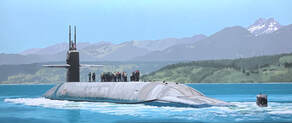
USS Nebraska Homecoming
16x38 Oil on Linen
USS Nebraska (SSBN-739) is the 14th ballistic missile submarine of the Ohio class and is named in honor of our 37th state. The submarine proudly carries the nickname “Big Red” in honor of the sports teams of the University of Nebraska-Lincoln. Nebraska’s keel was laid by General Dynamics’ Electric Boat division in Groton, Connecticut in July, 1987, was launched in August, 1992 and was commissioned eleven months later. Nebraska was originally assigned to Submarine Group 10 at Naval Submarine Base Kings Bay, Georgia. On 1 October 2004, Nebraska was transferred to Submarine Squadron 17 in Submarine Group 9 at Naval Base Kitsap, Bangor, Washington. In 2013 Nebraska transferred to Submarine Squadron 19 to conduct an Engineering Refueling Overhaul. As of November 2013, Nebraska had completed 62 deterrent patrols during its 20 years of service. Patrols are typically 77 days in duration followed by 35 days in port for maintenance. Following Patrol 54, Nebraska was awarded the "Battle E" for Submarine Squadron 17. Additionally, following Patrol 56, the submarine was awarded the "Battle E" for Submarine Squadron 17 for its second consecutive year. After completing an unprecedented 116-day patrol in late 2013, Nebraska was again awarded the "Battle E," her third in four years.
16x38 Oil on Linen
USS Nebraska (SSBN-739) is the 14th ballistic missile submarine of the Ohio class and is named in honor of our 37th state. The submarine proudly carries the nickname “Big Red” in honor of the sports teams of the University of Nebraska-Lincoln. Nebraska’s keel was laid by General Dynamics’ Electric Boat division in Groton, Connecticut in July, 1987, was launched in August, 1992 and was commissioned eleven months later. Nebraska was originally assigned to Submarine Group 10 at Naval Submarine Base Kings Bay, Georgia. On 1 October 2004, Nebraska was transferred to Submarine Squadron 17 in Submarine Group 9 at Naval Base Kitsap, Bangor, Washington. In 2013 Nebraska transferred to Submarine Squadron 19 to conduct an Engineering Refueling Overhaul. As of November 2013, Nebraska had completed 62 deterrent patrols during its 20 years of service. Patrols are typically 77 days in duration followed by 35 days in port for maintenance. Following Patrol 54, Nebraska was awarded the "Battle E" for Submarine Squadron 17. Additionally, following Patrol 56, the submarine was awarded the "Battle E" for Submarine Squadron 17 for its second consecutive year. After completing an unprecedented 116-day patrol in late 2013, Nebraska was again awarded the "Battle E," her third in four years.
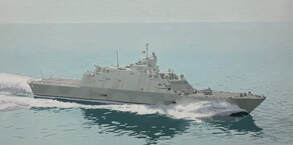
USS Milwuakee
15x30 Oil on Linen
USS Milwaukee (LCS-5) is the third Freedom Class Littoral Combat Ship (the class can be distinguished by the odd number. Independence class Littoral Combat Ships are identified by even numbered hulls.) She is the fifth ship to be named for the city of Milwaukee, the largest city in Wisconsin. The Milwuakee was sponsored by Mrs. Sylvia M. Panetta, wife of Secretary of Defense Leon E. Panetta and commissioned on 21 November 2015. Milwaukee includes additional stability improvements over the original Freedom design; the stern transom was lengthened and buoyancy tanks were added to the stern to increase weight service and enhance stability. The ship also features automated sensors to allow "conditions-based maintenance" and reduce crew overwork and fatigue issues that Freedom had on her first deployment. In 2021, the navy decided against decommissioning Milwaukee alongside several other older Freedom-class ships due to Milwaukee's active testing of a new anti-submarine mission package. Since then, Milwaukee returned to her homeport of Naval Station Mayport following a deployment to the 4th Fleet in April 2022. In October 2022, after a major electrical fire while docked in July of that year, Milwuakee left Mayport for her second deployment, returning in June of 2023.
15x30 Oil on Linen
USS Milwaukee (LCS-5) is the third Freedom Class Littoral Combat Ship (the class can be distinguished by the odd number. Independence class Littoral Combat Ships are identified by even numbered hulls.) She is the fifth ship to be named for the city of Milwaukee, the largest city in Wisconsin. The Milwuakee was sponsored by Mrs. Sylvia M. Panetta, wife of Secretary of Defense Leon E. Panetta and commissioned on 21 November 2015. Milwaukee includes additional stability improvements over the original Freedom design; the stern transom was lengthened and buoyancy tanks were added to the stern to increase weight service and enhance stability. The ship also features automated sensors to allow "conditions-based maintenance" and reduce crew overwork and fatigue issues that Freedom had on her first deployment. In 2021, the navy decided against decommissioning Milwaukee alongside several other older Freedom-class ships due to Milwaukee's active testing of a new anti-submarine mission package. Since then, Milwaukee returned to her homeport of Naval Station Mayport following a deployment to the 4th Fleet in April 2022. In October 2022, after a major electrical fire while docked in July of that year, Milwuakee left Mayport for her second deployment, returning in June of 2023.
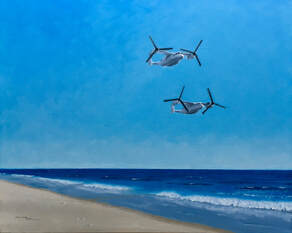
Osprey’s on the Prowl
16x20 Oil on Linen
The V-22 program originally included Navy 48 HV-22s, but none were ordered. In 2009, it was proposed that it replace the C-2 Greyhound for carrier onboard delivery (COD) duties. The advantage of the V-22 is the ability to deliver supplies and people between amphibious ships, aircraft carriers, and logistics ships beyond helicopter range. The C-2 can only deliver cargo to carriers, requiring further distribution to smaller vessels via helicopters. On 5 January 2015, the Navy and USMC signed a memorandum of understanding to buy the V-22 for the COD mission. It incorporates an extended-range fuel system for an 1,150 nm unrefueled range, a high-frequency radio for over-the-horizon communications, and a public address system to communicate with passengers. Its primary mission is long-range logistics and In February 2016, the Navy officially designated it the CMV-22B. The Navy ordered the first 39 CMV-22Bs in June 2018; initial operating capability was attained in 2021, with fielding to the fleet to be completed by the mid-2020s. The first CMV-22B made its initial flight in December 2019 and its first deployment began in summer 2021 aboard the USS Carl Vinson.
16x20 Oil on Linen
The V-22 program originally included Navy 48 HV-22s, but none were ordered. In 2009, it was proposed that it replace the C-2 Greyhound for carrier onboard delivery (COD) duties. The advantage of the V-22 is the ability to deliver supplies and people between amphibious ships, aircraft carriers, and logistics ships beyond helicopter range. The C-2 can only deliver cargo to carriers, requiring further distribution to smaller vessels via helicopters. On 5 January 2015, the Navy and USMC signed a memorandum of understanding to buy the V-22 for the COD mission. It incorporates an extended-range fuel system for an 1,150 nm unrefueled range, a high-frequency radio for over-the-horizon communications, and a public address system to communicate with passengers. Its primary mission is long-range logistics and In February 2016, the Navy officially designated it the CMV-22B. The Navy ordered the first 39 CMV-22Bs in June 2018; initial operating capability was attained in 2021, with fielding to the fleet to be completed by the mid-2020s. The first CMV-22B made its initial flight in December 2019 and its first deployment began in summer 2021 aboard the USS Carl Vinson.

USS Missouri in Tokyo Bay
11x38 Oil on Linen
In determining the proper place to conduct the Japanese surrender at the end of World War II the consensus was that the signing of the documents would carry more weight if it were done on a US warship. The USS Missouri was chosen for two main reasons; it was already the current flagship of Admiral Hulsey, and the ship’s namesake was from the home state of the new president, Harry S. Truman. Although the surrender was announced on 14 August, the surrender ceremony would not take place until 2 September 1945 in Tokyo Bay aboard the USS Missouri. A few days in advance of the signing the Missouri was led into the bay by a light cruiser and several mine sweepers, and ultimately to the spot depicted in the painting, Latitude 35 degrees 21’ 17” North and Longitude 139 degrees 45’ 36” East, which was incidentally virtually due east of Mt. Fujiyama. Taking positions on Missouri’s starboard flank soon would be the HMS Duke of York, the HMS King George V and the USS Colorado. All told there were another seventy allied warships and 163 allied support vessels in the bay for the security of the surrender.
11x38 Oil on Linen
In determining the proper place to conduct the Japanese surrender at the end of World War II the consensus was that the signing of the documents would carry more weight if it were done on a US warship. The USS Missouri was chosen for two main reasons; it was already the current flagship of Admiral Hulsey, and the ship’s namesake was from the home state of the new president, Harry S. Truman. Although the surrender was announced on 14 August, the surrender ceremony would not take place until 2 September 1945 in Tokyo Bay aboard the USS Missouri. A few days in advance of the signing the Missouri was led into the bay by a light cruiser and several mine sweepers, and ultimately to the spot depicted in the painting, Latitude 35 degrees 21’ 17” North and Longitude 139 degrees 45’ 36” East, which was incidentally virtually due east of Mt. Fujiyama. Taking positions on Missouri’s starboard flank soon would be the HMS Duke of York, the HMS King George V and the USS Colorado. All told there were another seventy allied warships and 163 allied support vessels in the bay for the security of the surrender.
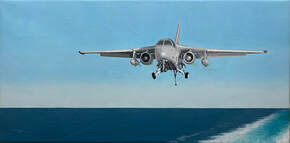
S-3 Viking
12x24 Oil on Linen
The Lockheed S-3 Viking became the anti-submarine warfare follow-on to the radial-engined S-2 Tracker in February 1974. The twin-engine turbofan-powered, four duty-position jet was a very reliable workhorse for the Navy, initially carrying automated anti-submarine weapons and in-flight refueling equipment. In the 1980s and 90s, the ES-3A Shadow electronic intelligence gathering version and the US-3A carrier-based cargo transport version were added. In the late 1990s most of the 186 S-3As built were upgraded to the S-3B and were introduced with a surface warfare and aerial refueling mission for the carrier battle group. The last S-3 was retired by NASA in mid-2021.
12x24 Oil on Linen
The Lockheed S-3 Viking became the anti-submarine warfare follow-on to the radial-engined S-2 Tracker in February 1974. The twin-engine turbofan-powered, four duty-position jet was a very reliable workhorse for the Navy, initially carrying automated anti-submarine weapons and in-flight refueling equipment. In the 1980s and 90s, the ES-3A Shadow electronic intelligence gathering version and the US-3A carrier-based cargo transport version were added. In the late 1990s most of the 186 S-3As built were upgraded to the S-3B and were introduced with a surface warfare and aerial refueling mission for the carrier battle group. The last S-3 was retired by NASA in mid-2021.
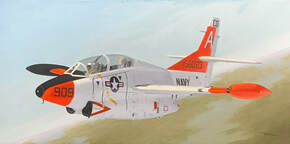
The Buckeye
12x24 Oil on Linen
The first version of the single-engine T-2 Buckeye entered service with the Navy in 1959 as the T2J-1. It was later re-designated the T-2A under the joint aircraft designation system in 1962. The aircraft was further redesigned and the single engine was replaced with two Pratt & Whitney
J60-P-6 turbojet engines in the T-2B. Later, the T-2C was fitted with two General Electric J85-GE-4 turbojet engines. Every jet-qualified Naval Aviator and virtually every Naval Flight Officer from the 1959 until 2004 received training in the T-2 Buckeye, a length of service that spanned more than four decades. The aircraft first exited the Naval Aviator strike pipeline in 2004, and exited the Naval Flight Officer tactical jet pipeline in 2008.
12x24 Oil on Linen
The first version of the single-engine T-2 Buckeye entered service with the Navy in 1959 as the T2J-1. It was later re-designated the T-2A under the joint aircraft designation system in 1962. The aircraft was further redesigned and the single engine was replaced with two Pratt & Whitney
J60-P-6 turbojet engines in the T-2B. Later, the T-2C was fitted with two General Electric J85-GE-4 turbojet engines. Every jet-qualified Naval Aviator and virtually every Naval Flight Officer from the 1959 until 2004 received training in the T-2 Buckeye, a length of service that spanned more than four decades. The aircraft first exited the Naval Aviator strike pipeline in 2004, and exited the Naval Flight Officer tactical jet pipeline in 2008.

Launch the Raiders!
18x30 Oil on Linen
On 0820 hours on18 April 1942, only five months after the Japanese attack on Pearl Harbor, USS Hornet (CV-8) launched a retaliatory raid on Tokyo and other industrial cities surrounding Tokyo Bay. The raid, as well as the first crew, was commanded by Lt. Col. James Doolittle using Army Air Corps B-25 bombers. These bombers were the only aircraft in the U.S. inventory that could both launch from a carrier and had the range to perform the planned mission. The weather was 9/10 broken cloud cover at 1000’ and visibility was excellent. Hornet was spotted some five hours before the planned launch time and an enemy transmission was intercepted, signaling that Tokyo had been alerted, so the raiders were given extra fuel containers and launched early. All sixteen raiders hit their targets, but in the big scheme of things caused relatively minor damage. However, the boost to American morale was immeasurable and the Japanese held back huge resources that would have been better utilized on various fronts, which continued throughout the war. At 0921 plane sixteen was launched and at 0927 the Hornet changed course to due east and at 25 knots arrived in Pearl Harbor on 25 April.
18x30 Oil on Linen
On 0820 hours on18 April 1942, only five months after the Japanese attack on Pearl Harbor, USS Hornet (CV-8) launched a retaliatory raid on Tokyo and other industrial cities surrounding Tokyo Bay. The raid, as well as the first crew, was commanded by Lt. Col. James Doolittle using Army Air Corps B-25 bombers. These bombers were the only aircraft in the U.S. inventory that could both launch from a carrier and had the range to perform the planned mission. The weather was 9/10 broken cloud cover at 1000’ and visibility was excellent. Hornet was spotted some five hours before the planned launch time and an enemy transmission was intercepted, signaling that Tokyo had been alerted, so the raiders were given extra fuel containers and launched early. All sixteen raiders hit their targets, but in the big scheme of things caused relatively minor damage. However, the boost to American morale was immeasurable and the Japanese held back huge resources that would have been better utilized on various fronts, which continued throughout the war. At 0921 plane sixteen was launched and at 0927 the Hornet changed course to due east and at 25 knots arrived in Pearl Harbor on 25 April.
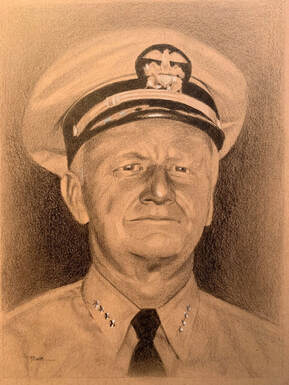
Admiral Chester W. Nimitz
12x9 Graphite on Toned Paper
Chester William Nimitz was a Fleet Admiral and during almost the entire time the United States was involved in World War II he served as Commander in Chief, US Pacific Fleet and Commander in Chief, Pacific Ocean Areas. He was born in Fredericksburg, TX on 24 February 1885. In May 1909 he was given command of the First Submarine Flotilla and the USS Plunger. He then spent most of his career in the Submarine Force. After the war he became CNO and was instrumental in gaining approval for nuclear propulsion for the USS Nautilus and future submarines. He died at his home on Yerba Buena Island in San Francisco Bay on 20 February 1966.
12x9 Graphite on Toned Paper
Chester William Nimitz was a Fleet Admiral and during almost the entire time the United States was involved in World War II he served as Commander in Chief, US Pacific Fleet and Commander in Chief, Pacific Ocean Areas. He was born in Fredericksburg, TX on 24 February 1885. In May 1909 he was given command of the First Submarine Flotilla and the USS Plunger. He then spent most of his career in the Submarine Force. After the war he became CNO and was instrumental in gaining approval for nuclear propulsion for the USS Nautilus and future submarines. He died at his home on Yerba Buena Island in San Francisco Bay on 20 February 1966.
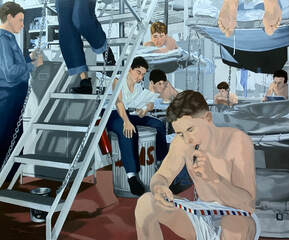
After Mail Call
20x24 Oil on Linen
This painting depicts crew members relaxing in the berthing compartment aboard the USS Yorktown “after mail call” on the eve of battle. The ship was then operating in tropical waters and the men are therefore wearing as little as possible to battle the heat. News from home is a very big thing, and they are read and reread until the paper is nearly worn out. The photo reference for this painting was taken by Lt. Charles E. Curlee, one of a team of the most prolific Navy World War II photographers.
20x24 Oil on Linen
This painting depicts crew members relaxing in the berthing compartment aboard the USS Yorktown “after mail call” on the eve of battle. The ship was then operating in tropical waters and the men are therefore wearing as little as possible to battle the heat. News from home is a very big thing, and they are read and reread until the paper is nearly worn out. The photo reference for this painting was taken by Lt. Charles E. Curlee, one of a team of the most prolific Navy World War II photographers.
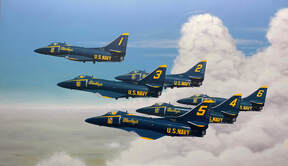
The Skyhawk Delta
20x34 Oil on Linen
In December 1973, the Navy Flight Exhibition Team was reorganized and commissioned as the United States Navy Flight Demonstration Squadron with the mission being more centered on Navy recruiting. In 1974, the Blue Angels transitioned to the new Douglas A-4F Skyhawk II with Commander Anthony Less becoming the new squadron's first "commanding officer" and “flight leader" (affectionately known as “Boss.”) At the end of the 1986 season, the Blue Angels had completed their 40th anniversary year under the leadership of Boss Commander Gil Rud, and during closing ceremonies unveiled that he would also be their first Boss to lead the team with a new aircraft, the McDonnell Douglas F/A-18 Hornet, through their 75th anniversary year.
20x34 Oil on Linen
In December 1973, the Navy Flight Exhibition Team was reorganized and commissioned as the United States Navy Flight Demonstration Squadron with the mission being more centered on Navy recruiting. In 1974, the Blue Angels transitioned to the new Douglas A-4F Skyhawk II with Commander Anthony Less becoming the new squadron's first "commanding officer" and “flight leader" (affectionately known as “Boss.”) At the end of the 1986 season, the Blue Angels had completed their 40th anniversary year under the leadership of Boss Commander Gil Rud, and during closing ceremonies unveiled that he would also be their first Boss to lead the team with a new aircraft, the McDonnell Douglas F/A-18 Hornet, through their 75th anniversary year.
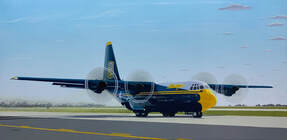
Fat Albert
15x30 Oil on Linen
In 2021 the Blue Angels started their new season not only with new Super Hornets, they also introduced their new C-130J sporting a new paint scheme. This aircraft is affectionately known as “Fat Albert,” which is operated by US Marines as part of the Blue Angels team. Depicted here, Fat Albert is taxiing for takeoff for an aerial demonstration of its capabilities at the 3 July 2021 Kansas City Airshow at the New Century Air Center in Gardner, Kansas. With 29% more thrust than previous models, Fat Albert no longer needs the Rocket Assisted Takeoff (RATO) to perform its dramatic, high-angle takeoff. Beside it’s impressive demonstration, Fat Albert also supports the Blue Angels’ logistically carrying spare parts, equipment, and support personnel between shows.
15x30 Oil on Linen
In 2021 the Blue Angels started their new season not only with new Super Hornets, they also introduced their new C-130J sporting a new paint scheme. This aircraft is affectionately known as “Fat Albert,” which is operated by US Marines as part of the Blue Angels team. Depicted here, Fat Albert is taxiing for takeoff for an aerial demonstration of its capabilities at the 3 July 2021 Kansas City Airshow at the New Century Air Center in Gardner, Kansas. With 29% more thrust than previous models, Fat Albert no longer needs the Rocket Assisted Takeoff (RATO) to perform its dramatic, high-angle takeoff. Beside it’s impressive demonstration, Fat Albert also supports the Blue Angels’ logistically carrying spare parts, equipment, and support personnel between shows.
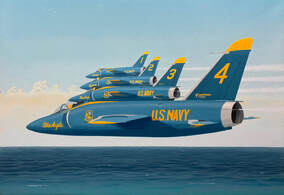
Grumman Tigers
15x21 Oil on Linen
After the 1956 show season, the Blue Angels transitioned from the F9F Cougar to the F11F Grumman Tiger. The Blue Angels flew the F11F during the show seasons of 1957-1969, which was longer than any other aircraft to that point. The F11F was the first supersonic carrier-based aircraft, ahead of its time in many ways in aircraft development. However, only 199 F11F aircraft were produced as technology ramped up at an exponential rate and in 1970 the Blue Angels transitioned to the McDonnell-Douglas F-4.
15x21 Oil on Linen
After the 1956 show season, the Blue Angels transitioned from the F9F Cougar to the F11F Grumman Tiger. The Blue Angels flew the F11F during the show seasons of 1957-1969, which was longer than any other aircraft to that point. The F11F was the first supersonic carrier-based aircraft, ahead of its time in many ways in aircraft development. However, only 199 F11F aircraft were produced as technology ramped up at an exponential rate and in 1970 the Blue Angels transitioned to the McDonnell-Douglas F-4.
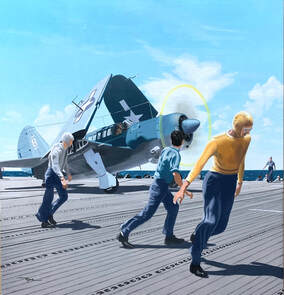
Helldiver Recovered
17x16 Oil on Linen
In 1943 the Curtiss SBC2 Helldiver began to be delivered to the US Naval fleet to augment, and sometimes replace the SBD Dauntless as the Navy’s predominant dive-bomber. Here in the early spring of 1944 a Helldiver has just returned to the USS Franklin (CV-13) from a mission, its tail hook has been released from the wire and it begins its taxi to the front end of the flight deck of the carrier. Once all of the aircraft were recovered the deck crew would reposition the aircraft to the aft end of the flight deck in preparation for the next launch. Official photo reference for this painting was taken by Horace Bristol.
17x16 Oil on Linen
In 1943 the Curtiss SBC2 Helldiver began to be delivered to the US Naval fleet to augment, and sometimes replace the SBD Dauntless as the Navy’s predominant dive-bomber. Here in the early spring of 1944 a Helldiver has just returned to the USS Franklin (CV-13) from a mission, its tail hook has been released from the wire and it begins its taxi to the front end of the flight deck of the carrier. Once all of the aircraft were recovered the deck crew would reposition the aircraft to the aft end of the flight deck in preparation for the next launch. Official photo reference for this painting was taken by Horace Bristol.
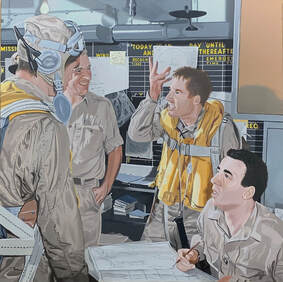
Mission Debrief
24x24 oil on linen
SBD-5 pilot Ensign Chuck Porter is telling his story as he is debriefed by ACIO Bob Steiner in the ready room onboard the USS Yorktown (CV-10, part of Task Force 14) on 6 October 1943 following the second day of attacks on Japanese-held Wake Island. Around Porter’s neck is a lanyard with the flashlight he used in the cockpit during the dark, early morning launch. To his immediate right is the unit’s “Weatherguesser,” Jim Vonk. The two-day attack was very successful, but taking the island was not the objective, denying the unrestricted use of the island was. The island had been taken by the Japanese in two attempts: the first was just a few hours after the attack on Pearl Harbor on 8 December 1941 (Wake Island is on the west side of the International Date Line,) which was repelled by the garrison of Marines and civilian engineers on the island, and the second succeeded on 23 December the same year. The official 1943 photo used for reference on this painting was taken by Charles Kerlee.
24x24 oil on linen
SBD-5 pilot Ensign Chuck Porter is telling his story as he is debriefed by ACIO Bob Steiner in the ready room onboard the USS Yorktown (CV-10, part of Task Force 14) on 6 October 1943 following the second day of attacks on Japanese-held Wake Island. Around Porter’s neck is a lanyard with the flashlight he used in the cockpit during the dark, early morning launch. To his immediate right is the unit’s “Weatherguesser,” Jim Vonk. The two-day attack was very successful, but taking the island was not the objective, denying the unrestricted use of the island was. The island had been taken by the Japanese in two attempts: the first was just a few hours after the attack on Pearl Harbor on 8 December 1941 (Wake Island is on the west side of the International Date Line,) which was repelled by the garrison of Marines and civilian engineers on the island, and the second succeeded on 23 December the same year. The official 1943 photo used for reference on this painting was taken by Charles Kerlee.
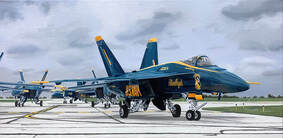
New Century Practice
10x20 Oil on Linen
Typically the Blue Angels arrive midday on Thursday in the town in which they will be performing over the weekend, which includes all sorts of arrival activities including any maintenance tweaks on the aircraft before each of the three pairs fly the show area to get a feel for the location and confirm ground checkpoints. On Friday afternoon they will conduct a practice show, which is their already perfected itinerary flown in the new location. On Friday 2 July 2021 the Blue Angels conducted their practice show at New Century Air Center in Gardner, Kansas, the site of the 2021 Kansas City Air Show. After each show the team will taxi back to parking “in formation,” which is depicted here. Despite the threatening-looking weather, the team was able to do a full “high show” practice.
10x20 Oil on Linen
Typically the Blue Angels arrive midday on Thursday in the town in which they will be performing over the weekend, which includes all sorts of arrival activities including any maintenance tweaks on the aircraft before each of the three pairs fly the show area to get a feel for the location and confirm ground checkpoints. On Friday afternoon they will conduct a practice show, which is their already perfected itinerary flown in the new location. On Friday 2 July 2021 the Blue Angels conducted their practice show at New Century Air Center in Gardner, Kansas, the site of the 2021 Kansas City Air Show. After each show the team will taxi back to parking “in formation,” which is depicted here. Despite the threatening-looking weather, the team was able to do a full “high show” practice.
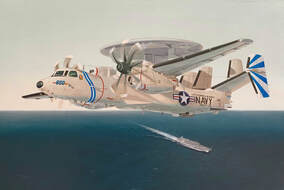
Eyes of the Fleet
16x24 Oil on Linen
The Northrop Grumman E-2 Hawkeye is an all-weather, carrier-capable tactical airborne early warning (AEW) aircraft. This aircraft was designed and developed during the late 1950s and early 1960s by the Grumman Aircraft Company for the United States Navy as a replacement for the, earlier E-1 Tracer, which was rapidly becoming obsolete. The aircraft's original performance was upgraded with the E-2B and E-2C versions, where most of the changes were made to the radar and radio communications due to advances in electronic integrated circuits and other electronics. The fourth version of the Hawkeye, pictured here, is the E-2D, which first flew in 2007. The aircraft is operated by a crew of five: the pilot and co-pilot on the flight deck, and the combat information center officer, air control officer and radar perator, whose stations are further aft in the fuselage. Variants of the Hawkeye have been in continuous production since 1960, giving it the longest production run of any carrier-based aircraft. Grumman also used the basic layout of the E-2 to produce the Grumman C-2 Greyhound cargo aircraft.
16x24 Oil on Linen
The Northrop Grumman E-2 Hawkeye is an all-weather, carrier-capable tactical airborne early warning (AEW) aircraft. This aircraft was designed and developed during the late 1950s and early 1960s by the Grumman Aircraft Company for the United States Navy as a replacement for the, earlier E-1 Tracer, which was rapidly becoming obsolete. The aircraft's original performance was upgraded with the E-2B and E-2C versions, where most of the changes were made to the radar and radio communications due to advances in electronic integrated circuits and other electronics. The fourth version of the Hawkeye, pictured here, is the E-2D, which first flew in 2007. The aircraft is operated by a crew of five: the pilot and co-pilot on the flight deck, and the combat information center officer, air control officer and radar perator, whose stations are further aft in the fuselage. Variants of the Hawkeye have been in continuous production since 1960, giving it the longest production run of any carrier-based aircraft. Grumman also used the basic layout of the E-2 to produce the Grumman C-2 Greyhound cargo aircraft.
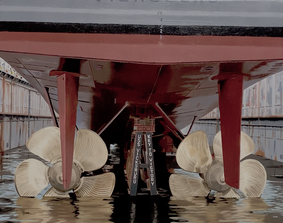
Key to Victory
16x20 Oil on Linen
Recently the USS Vicksburg (CG-69), a guided missile cruiser was in dry dock at the Norfolk Naval Yard as part of an external checkup prior to more time docked for weapons and crew compartment upgrades. Here to dry dock is being slowly “sunk” to float the Vicksburg at the surrounding water level before moving to a dock nearby for the remainder of her upgrade work. As of the finish date on this painting in May 2022, the Vicksburg has been placed on the decommission list due to changing Naval requirements worldwide.
16x20 Oil on Linen
Recently the USS Vicksburg (CG-69), a guided missile cruiser was in dry dock at the Norfolk Naval Yard as part of an external checkup prior to more time docked for weapons and crew compartment upgrades. Here to dry dock is being slowly “sunk” to float the Vicksburg at the surrounding water level before moving to a dock nearby for the remainder of her upgrade work. As of the finish date on this painting in May 2022, the Vicksburg has been placed on the decommission list due to changing Naval requirements worldwide.
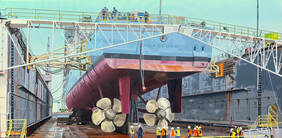
High and Dry
15x30 Oil on Linen
Recently the USS Vicksburg (CG-69), a guided missile cruiser was in dry dock at the Norfolk Naval Yard as part of an external checkup prior to more time docked for weapons and crew compartment upgrades. Here the dry dock has just been floated and the Vicksburg is completely out of the water for external repairs and new paint. As of the finish date on this painting in May 2022, the Vicksburg has been placed on the decommission list due to changing Naval requirements worldwide.
15x30 Oil on Linen
Recently the USS Vicksburg (CG-69), a guided missile cruiser was in dry dock at the Norfolk Naval Yard as part of an external checkup prior to more time docked for weapons and crew compartment upgrades. Here the dry dock has just been floated and the Vicksburg is completely out of the water for external repairs and new paint. As of the finish date on this painting in May 2022, the Vicksburg has been placed on the decommission list due to changing Naval requirements worldwide.
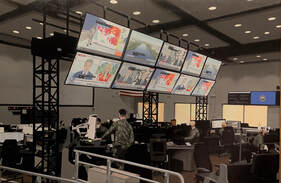
Securing NMCI
21x32 Oil on Linen
This was the scene on the morning of 22 September 2022 in one of the facilities of the Naval Information Warfare network in the area of Norfolk, Virginia. This particular unit’s concern is the security and physical operation of the Navy and Marine Corps Internet system.
21x32 Oil on Linen
This was the scene on the morning of 22 September 2022 in one of the facilities of the Naval Information Warfare network in the area of Norfolk, Virginia. This particular unit’s concern is the security and physical operation of the Navy and Marine Corps Internet system.
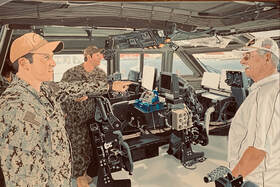
Then Meets Now
20x30 Oil on Canvas
On 21 September 2021, Ron Miriello, a “River Rat” Vietnam war veteran of the US Navy’s Mobile Riverine Task Force 117, River Assault squadron 9 on Armored Troop Carrier (ATC) T-91-13 in 1968 was introduced to the modern Maritime Expeditionary Security Squadron 2 in the squadron and on one of their Mark VI patrol boats at the Little Creek Naval Base in Norfolk, VA. Although the mission has changed dramatically, both Ron and the people in MESRON 2 were fascinated to talk about the differences between then and now. Depicted here is Lt. James Browning pointing and describing to
Ron how the boat can be controlled with just the two controls to Ron’s right. Behind Lt. Browning are EN1 Trevon Henson (left) and HT1 Cory Bowman.
20x30 Oil on Canvas
On 21 September 2021, Ron Miriello, a “River Rat” Vietnam war veteran of the US Navy’s Mobile Riverine Task Force 117, River Assault squadron 9 on Armored Troop Carrier (ATC) T-91-13 in 1968 was introduced to the modern Maritime Expeditionary Security Squadron 2 in the squadron and on one of their Mark VI patrol boats at the Little Creek Naval Base in Norfolk, VA. Although the mission has changed dramatically, both Ron and the people in MESRON 2 were fascinated to talk about the differences between then and now. Depicted here is Lt. James Browning pointing and describing to
Ron how the boat can be controlled with just the two controls to Ron’s right. Behind Lt. Browning are EN1 Trevon Henson (left) and HT1 Cory Bowman.
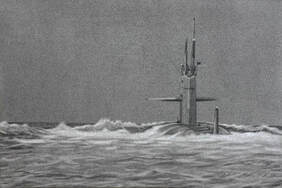
Underway
13x19.5 Charcoal on Paper
Depicted is the Los Angeles-class submarine USS Newport News (SSN 750), which is based in Norfolk, Virginia. The Newport News has just departed after a brief stop with a patrol boat from Coastal Riverine Squadron One to exchange personnel in the Gulf of Tadjoura on 31 January 2020. The photo reference for this drawing was taken by Hospital Corpsman First Class Kenji Shiroma.
13x19.5 Charcoal on Paper
Depicted is the Los Angeles-class submarine USS Newport News (SSN 750), which is based in Norfolk, Virginia. The Newport News has just departed after a brief stop with a patrol boat from Coastal Riverine Squadron One to exchange personnel in the Gulf of Tadjoura on 31 January 2020. The photo reference for this drawing was taken by Hospital Corpsman First Class Kenji Shiroma.
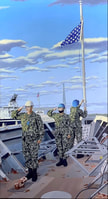
Morning Colors
32x16 Oil on Linen
At 0800 hours on 24 September 2021 this was the scene at the bow aboard the Guided Missile Cruiser USS Vicksburg (CG-69) as the Star-Spangled Banner sounded at the Navy Yard. This ship had recently come out of dry dock and was now getting improvements to her superstructure and combat systems that will allow her to remain with the fleet for many years to come. The flag being raised here is the Naval Jack, which is the canton (upper hoist corner) of the U.S. Ensign. While the ship is anchored or moored, the jack is flown at the bow and the ensign is flown at the stern. Once underway, the jack is stowed and the ensign is flown from the main mast.
32x16 Oil on Linen
At 0800 hours on 24 September 2021 this was the scene at the bow aboard the Guided Missile Cruiser USS Vicksburg (CG-69) as the Star-Spangled Banner sounded at the Navy Yard. This ship had recently come out of dry dock and was now getting improvements to her superstructure and combat systems that will allow her to remain with the fleet for many years to come. The flag being raised here is the Naval Jack, which is the canton (upper hoist corner) of the U.S. Ensign. While the ship is anchored or moored, the jack is flown at the bow and the ensign is flown at the stern. Once underway, the jack is stowed and the ensign is flown from the main mast.

First UAV Tanker Refueling
14x32 Oil on Linen
On June 4, 2021 the U.S. Navy performed its first-ever aerial refueling between a manned aircraft and a tanker unmanned aerial vehicle (UAV.) The tanker was a MQ-25 Stingray owned by Boeing and the Boeing F/A-18F Super Hornet was flown by two aviators from Air Test and Evaluation Squadron
23 at NAS Patuxent River, who were in radio contact with the drone operator at a ground station; both aircraft flying the test mission out of Mid-America Airport in Mascoutah, Illinois. Several “dry” connections and disconnections were made first to test procedures at 10,000’, followed by a “wet connection” in which the drone passed 300 pounds of fuel to the fighter. Another wet connection was made at 16,000’ transferring 25 pounds of fuel. The aircraft were connected for more than ten minutes during the test flight. Subsequent compatibility tests have also been conducted with the F-35C and E-2D aircraft. The Navy plans to take delivery of seven engineering and manufacturing development UAVs to conduct more thorough testing around the fall of 2022 from a carrier and anticipates operational capability in 2025.
14x32 Oil on Linen
On June 4, 2021 the U.S. Navy performed its first-ever aerial refueling between a manned aircraft and a tanker unmanned aerial vehicle (UAV.) The tanker was a MQ-25 Stingray owned by Boeing and the Boeing F/A-18F Super Hornet was flown by two aviators from Air Test and Evaluation Squadron
23 at NAS Patuxent River, who were in radio contact with the drone operator at a ground station; both aircraft flying the test mission out of Mid-America Airport in Mascoutah, Illinois. Several “dry” connections and disconnections were made first to test procedures at 10,000’, followed by a “wet connection” in which the drone passed 300 pounds of fuel to the fighter. Another wet connection was made at 16,000’ transferring 25 pounds of fuel. The aircraft were connected for more than ten minutes during the test flight. Subsequent compatibility tests have also been conducted with the F-35C and E-2D aircraft. The Navy plans to take delivery of seven engineering and manufacturing development UAVs to conduct more thorough testing around the fall of 2022 from a carrier and anticipates operational capability in 2025.
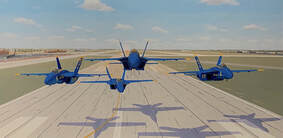
Diamond Takeoff
24x48 Oil on Linen
On July 3, 2021 the Blue Angels performed their incredible flying feats for the Kansas City Airshow at New Century Air Center, in Gardner, Kansas. This airfield was previously known as the Olathe Naval Air Station, constructed to train Navy pilots during World War II and was activated in 1942. Depicted is the takeoff of the four Blue Angels that constitute the Diamond. The Slot Pilot has
called for the landing gear to be raised and is transitioning from the fingertip takeoff position on number two’s starboard side to the slot position just behind and below the leader.
24x48 Oil on Linen
On July 3, 2021 the Blue Angels performed their incredible flying feats for the Kansas City Airshow at New Century Air Center, in Gardner, Kansas. This airfield was previously known as the Olathe Naval Air Station, constructed to train Navy pilots during World War II and was activated in 1942. Depicted is the takeoff of the four Blue Angels that constitute the Diamond. The Slot Pilot has
called for the landing gear to be raised and is transitioning from the fingertip takeoff position on number two’s starboard side to the slot position just behind and below the leader.
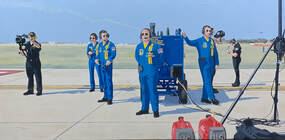
At the “Comm Cart”
15x30 Oil on Linen
On July 24, 2021 the Blue Angels performed their incredible flying feats for the Fargo Airshow in Fargo, North Dakota. Depicted are Blue Angels staff that support flying operations during demonstrations who are at the “Comm Cart” - a mobile cart that houses radio communication equipment, a remote weather station for winds and atmospheric pressure, light guns and
binoculars. The solos have just completed a crossing maneuver and attention shifts to the diamond coming in for their next demo.
15x30 Oil on Linen
On July 24, 2021 the Blue Angels performed their incredible flying feats for the Fargo Airshow in Fargo, North Dakota. Depicted are Blue Angels staff that support flying operations during demonstrations who are at the “Comm Cart” - a mobile cart that houses radio communication equipment, a remote weather station for winds and atmospheric pressure, light guns and
binoculars. The solos have just completed a crossing maneuver and attention shifts to the diamond coming in for their next demo.
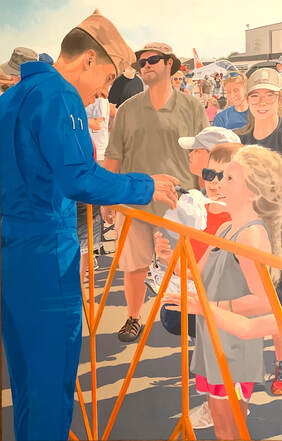
A Dream is Born
28x18 Oil on Linen
On July 3, 2021 the Blue Angels performed their incredible flying feats for the Kansas City Airshow at New Century Air Center, in Gardner, Kansas. Following their demonstration the pilots spaced themselves at the fence line to interact with the public and sign autographs for all the fans who are eager to meet them. On this Saturday afternoon a young lady is next in line and hands her cap to Lcdr. Jim Cox, #4 - the Slot Pilot, and by the expression on her face it is apparent that “a dream is born.” Regardless of the difficulty involved in what these young people say they want to do, the Blue Angels encourage them that they can, and should, do it.
28x18 Oil on Linen
On July 3, 2021 the Blue Angels performed their incredible flying feats for the Kansas City Airshow at New Century Air Center, in Gardner, Kansas. Following their demonstration the pilots spaced themselves at the fence line to interact with the public and sign autographs for all the fans who are eager to meet them. On this Saturday afternoon a young lady is next in line and hands her cap to Lcdr. Jim Cox, #4 - the Slot Pilot, and by the expression on her face it is apparent that “a dream is born.” Regardless of the difficulty involved in what these young people say they want to do, the Blue Angels encourage them that they can, and should, do it.
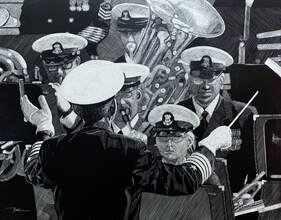
Navy Band
12x16 Scratch Board
The United States Band has been a constant in the United States since 1925, but what has not been constant has been the structure of the organization itself. From Humble beginnings as a small band at the Navy Yard in the early 20th century, the Navy Band has grown in both stature and function. More than simply a concert and ceremonial band, the Navy Band now consists of a mixed choir, a jazz ensemble, a country/bluegrass band and a contemporary music ensemble. The addition of the Sea Chanters, Commodores Jazz Ensemble, Country Current and Cruisers has redefined what music is possible from the Navy Band. As ceremonial commitments increase and more events require the band’s presence, the Navy Band is better positioned to fulfill its mission than at any
other time in its history. The changes it has undergone over the years are integral to its position now as the “World’s Finest” and an essential part of the United States Navy and the U.S. as a whole.
12x16 Scratch Board
The United States Band has been a constant in the United States since 1925, but what has not been constant has been the structure of the organization itself. From Humble beginnings as a small band at the Navy Yard in the early 20th century, the Navy Band has grown in both stature and function. More than simply a concert and ceremonial band, the Navy Band now consists of a mixed choir, a jazz ensemble, a country/bluegrass band and a contemporary music ensemble. The addition of the Sea Chanters, Commodores Jazz Ensemble, Country Current and Cruisers has redefined what music is possible from the Navy Band. As ceremonial commitments increase and more events require the band’s presence, the Navy Band is better positioned to fulfill its mission than at any
other time in its history. The changes it has undergone over the years are integral to its position now as the “World’s Finest” and an essential part of the United States Navy and the U.S. as a whole.
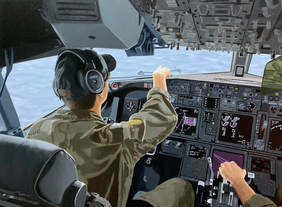
Poseidon Searching
18x24 Oil on Linen
On 12 April, 2017 Lt. Sean Buckely and his P-8A Poseidon crew, assigned to Patrol Squadron (VP) 8, are searching on station for the Republic of Korea vessel Stellar Daisy as part of search and rescue efforts after the vessel disappeared in the South Atlantic on 31 March. The photo reference for this painting was taken by Lt. Mark Baden.
18x24 Oil on Linen
On 12 April, 2017 Lt. Sean Buckely and his P-8A Poseidon crew, assigned to Patrol Squadron (VP) 8, are searching on station for the Republic of Korea vessel Stellar Daisy as part of search and rescue efforts after the vessel disappeared in the South Atlantic on 31 March. The photo reference for this painting was taken by Lt. Mark Baden.
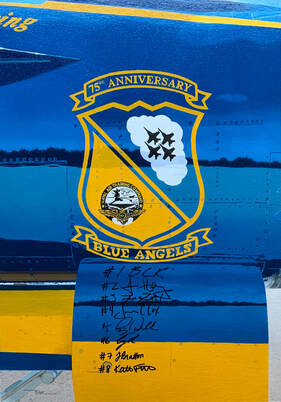
A Milestone Year
20x14 Oil on Linen
The Blue Angels have celebrated three major milestones in 2021. First, it is the 75th anniversary for the US Navy’s flight demonstration team, which began in 1946 at the direction of then CNO Admiral Chester Nimitz. This year the team also did something that hasn’t been done since 1987 - they changed the aircraft used in their demonstrations. In 2021 the team transitioned from the Legacy Hornet to the F/A-18E/F Super Hornet, which is larger and carries more fuel, allowing more afterburner use and enhanced maneuvers. Lastly, the team’s support aircraft, known as Fat Albert, was also updated from a C-130T to a C-130J Super Hercules, vastly increasing their effectiveness and efficiency. Blue Angels numbers one through eight signed this painting at the 2021 Fargo Airshow in July.
20x14 Oil on Linen
The Blue Angels have celebrated three major milestones in 2021. First, it is the 75th anniversary for the US Navy’s flight demonstration team, which began in 1946 at the direction of then CNO Admiral Chester Nimitz. This year the team also did something that hasn’t been done since 1987 - they changed the aircraft used in their demonstrations. In 2021 the team transitioned from the Legacy Hornet to the F/A-18E/F Super Hornet, which is larger and carries more fuel, allowing more afterburner use and enhanced maneuvers. Lastly, the team’s support aircraft, known as Fat Albert, was also updated from a C-130T to a C-130J Super Hercules, vastly increasing their effectiveness and efficiency. Blue Angels numbers one through eight signed this painting at the 2021 Fargo Airshow in July.
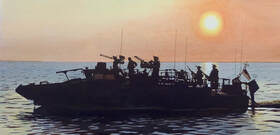
Dusk Patrol
16x32 Oil on Linen
In July of 2011 the crew of a Riverine Command Boat (RCB) assigned to River Squadron 2 (RIVRON 2) conducts a pre-deployment dusk patrol exercise off of Joint Expeditionary Base Little Creek-Fort Story in the Norfolk area of Virginia. RCBs are outfitted with a number of light, medium and heavy weapons including .50 caliber heavy machine guns and GAU-19 mini-guns. These fast boats are approximately 50 feet long and can reach speeds up to 40 knots on the water. The photo reference for this painting was taken by MCS1 Andre McIntyre.
16x32 Oil on Linen
In July of 2011 the crew of a Riverine Command Boat (RCB) assigned to River Squadron 2 (RIVRON 2) conducts a pre-deployment dusk patrol exercise off of Joint Expeditionary Base Little Creek-Fort Story in the Norfolk area of Virginia. RCBs are outfitted with a number of light, medium and heavy weapons including .50 caliber heavy machine guns and GAU-19 mini-guns. These fast boats are approximately 50 feet long and can reach speeds up to 40 knots on the water. The photo reference for this painting was taken by MCS1 Andre McIntyre.
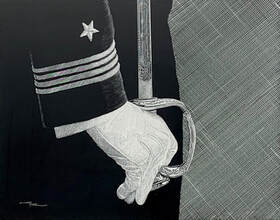
Attention Midshipmen
11x14 Scratch Board
A U.S. Naval Academy midshipman stands at attention before a formal parade on the school’s campus. The midshipmen will participate in three additional parades before the end of their spring semester. The reference photo for this piece was taken by MCS 1 Chad Runge.
11x14 Scratch Board
A U.S. Naval Academy midshipman stands at attention before a formal parade on the school’s campus. The midshipmen will participate in three additional parades before the end of their spring semester. The reference photo for this piece was taken by MCS 1 Chad Runge.
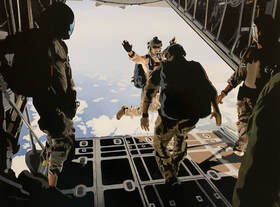
Geronimo!
18x24 Oil on Linen
Explosive ordnance disposal technicians assigned to Explosive Ordnance Disposal Mobile Unit (EODMU) 5 perform a free fall jump from the “business end” of a C-130 during military free fall jump sustainment training in Santa Rita, Guam. EODMU-5 is assigned to Commander, Task Force (CTF) 75, the primary expeditionary task force responsible for the planning and execution of coastal riverine operations, explosive ordnance disposal, diving engineering and construction, and underwater construction in the U.S. 7th fleet area of responsibility.
18x24 Oil on Linen
Explosive ordnance disposal technicians assigned to Explosive Ordnance Disposal Mobile Unit (EODMU) 5 perform a free fall jump from the “business end” of a C-130 during military free fall jump sustainment training in Santa Rita, Guam. EODMU-5 is assigned to Commander, Task Force (CTF) 75, the primary expeditionary task force responsible for the planning and execution of coastal riverine operations, explosive ordnance disposal, diving engineering and construction, and underwater construction in the U.S. 7th fleet area of responsibility.
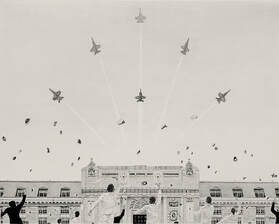
Graduation Day
10.25x15 Graphite on Watercolor Paper
Midshipmen “toss their covers” in front of Bancroft Hall at the United States Naval Academy as the Navy’s Blue Angels fly over in May of 2020. Graduation in 2020 was done in five swearing-in ceremonies and one virtual ceremony due to the COVID distancing restrictions in place at the time. The cover toss is a tradition which ends the ceremony that originated in 1912. The Naval Academy prepares young men and women in four years of instruction, and physical, mental and leadership testing, to become professional officers of competence, character and compassion in the U.S. Navy and Marine Corps.
10.25x15 Graphite on Watercolor Paper
Midshipmen “toss their covers” in front of Bancroft Hall at the United States Naval Academy as the Navy’s Blue Angels fly over in May of 2020. Graduation in 2020 was done in five swearing-in ceremonies and one virtual ceremony due to the COVID distancing restrictions in place at the time. The cover toss is a tradition which ends the ceremony that originated in 1912. The Naval Academy prepares young men and women in four years of instruction, and physical, mental and leadership testing, to become professional officers of competence, character and compassion in the U.S. Navy and Marine Corps.
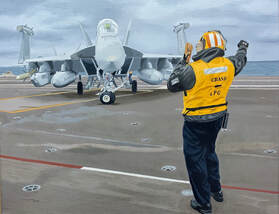
Launch the Growler
16x20 Oil on Linen
One of many aircraft handlers, identified by wearing a bright “yellow shirt,” is responsible for directing aircraft around the carrier’s relatively small and chaotic deck. As one can imagine, the deck of a carrier is a very loud place, so the handlers “speak” through a myriad of hand signals. His current signal is directing the pilot to turn hard left, and during the turn the pilot will be directed to another yellow shirt handler, the catapult officer. The Growler is an EA-18G, which is an electronic warfare version of the Boeing F/A-18 Super Hornet that joined the fleet in 2009 to replace the aged Northrop Grumman EA-6B Prowler. It is capable of jamming enemy communications, and airborne and surface-to-air radar, as well as being capable to perform all other missions of the Super Hornet.
16x20 Oil on Linen
One of many aircraft handlers, identified by wearing a bright “yellow shirt,” is responsible for directing aircraft around the carrier’s relatively small and chaotic deck. As one can imagine, the deck of a carrier is a very loud place, so the handlers “speak” through a myriad of hand signals. His current signal is directing the pilot to turn hard left, and during the turn the pilot will be directed to another yellow shirt handler, the catapult officer. The Growler is an EA-18G, which is an electronic warfare version of the Boeing F/A-18 Super Hornet that joined the fleet in 2009 to replace the aged Northrop Grumman EA-6B Prowler. It is capable of jamming enemy communications, and airborne and surface-to-air radar, as well as being capable to perform all other missions of the Super Hornet.
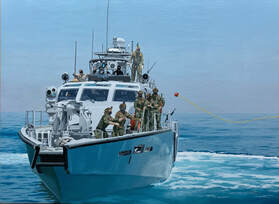
Patrolling the Arabian Gulf
18x24 Oil on Linen
A Mark VI patrol boat assigned to Commander, Task Force 56 prepares for a towing exercise with a coastal patrol ship in May 2020 in the Arabian Gulf. Here a shot line, attached to a messenger line, has been fired from the coastal patrol ship, which is about to be received by the Mark VI patrol boat. Attached to the messenger line is the coastal patrol boat’s tow cable, which will be secured to the anchor chain of the patrol
boat for towing. The towing is done to allow the Mark VI patrol boat to operate deeper into the Arabian Gulf, enhancing the Task Force’s overall capabilities by leveraging the longer range and bigger firepower of the coastal patrol boat, with the faster and more maneuverable Mark VI patrol boat. Both boats gain experience in close-quarter maneuvering challenges during towing while adding the capabilities of the Mark VI to the Task Force’s mission in the Arabian Gulf.
18x24 Oil on Linen
A Mark VI patrol boat assigned to Commander, Task Force 56 prepares for a towing exercise with a coastal patrol ship in May 2020 in the Arabian Gulf. Here a shot line, attached to a messenger line, has been fired from the coastal patrol ship, which is about to be received by the Mark VI patrol boat. Attached to the messenger line is the coastal patrol boat’s tow cable, which will be secured to the anchor chain of the patrol
boat for towing. The towing is done to allow the Mark VI patrol boat to operate deeper into the Arabian Gulf, enhancing the Task Force’s overall capabilities by leveraging the longer range and bigger firepower of the coastal patrol boat, with the faster and more maneuverable Mark VI patrol boat. Both boats gain experience in close-quarter maneuvering challenges during towing while adding the capabilities of the Mark VI to the Task Force’s mission in the Arabian Gulf.
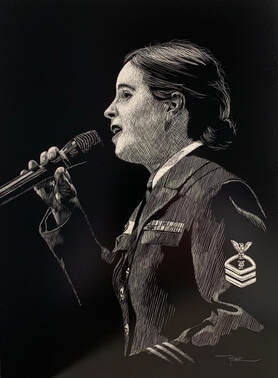
Navy Vocal Soloist
12x9 Scratch Board
Depicted is a vocal soloist with the United States Navy’s official chorus, the Sea Chanters. The ensemble performs a variety of music including traditional choral music, sea chanteys, patriotic fare, opera, Broadway and contemporary music. The Sea Chanters perform for the public regularly on national tours and in Washington, D.C. While in the nations capital they perform for the president, vice president and numerous congressional, military and foreign dignitaries. In 1956, Lt. Harold Fultz, then the band’s assistant leader, organized a vocal group from the Navy School of Music to sing chanteys and patriotic songs for the State of the Nation dinner. Recognizing the ensemble’s immediate success, then CNO Adm. Arleigh Burke transferred the group to the Navy Band, gave them their current name and tasked this all-male chorus with perpetuation the songs of the sea. In 1980 the group added women to its ranks and expanded its repertoire to include everything from Brahms to Broadway.
12x9 Scratch Board
Depicted is a vocal soloist with the United States Navy’s official chorus, the Sea Chanters. The ensemble performs a variety of music including traditional choral music, sea chanteys, patriotic fare, opera, Broadway and contemporary music. The Sea Chanters perform for the public regularly on national tours and in Washington, D.C. While in the nations capital they perform for the president, vice president and numerous congressional, military and foreign dignitaries. In 1956, Lt. Harold Fultz, then the band’s assistant leader, organized a vocal group from the Navy School of Music to sing chanteys and patriotic songs for the State of the Nation dinner. Recognizing the ensemble’s immediate success, then CNO Adm. Arleigh Burke transferred the group to the Navy Band, gave them their current name and tasked this all-male chorus with perpetuation the songs of the sea. In 1980 the group added women to its ranks and expanded its repertoire to include everything from Brahms to Broadway.
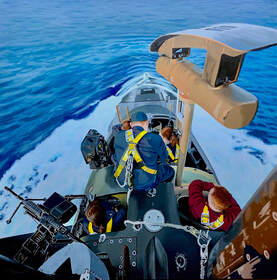
Florida Bridge
30x30 Oil on Canvas
This is the bridge of the USS Florida as it conducts routine navigation and watch procedures on the surface of the Mediterranean Sea in the fall of 2019. The USS Florida is the first submarine and the sixth United States Navy ship to bear the name of the state. It was the second submarine to complete the conversion from a ballistic-missile submarine to a guided-missile submarine.
30x30 Oil on Canvas
This is the bridge of the USS Florida as it conducts routine navigation and watch procedures on the surface of the Mediterranean Sea in the fall of 2019. The USS Florida is the first submarine and the sixth United States Navy ship to bear the name of the state. It was the second submarine to complete the conversion from a ballistic-missile submarine to a guided-missile submarine.

Straight-In to the Carrier
8x30 Oil on Linen
Pictured is a Grumman C-2 Greyhound, which is designed to transport high-priority cargo, mail, and passengers between shore bases and aircraft carriers of the United States Navy. Its primary mission is called “Carrier Onboard Delivery,” or COD. The C-2 first flew in 1964 with production and deliveries following the next year. The initial Greyhound aircraft underwent a major overhaul in 1973 and in 1984, more C-2As were ordered. In 2010 all C-2A aircraft received upgrades, which increased the number of propellers from four to eight blades per engine and converted the original control panel to a “glass cockpit.” In 2020 the Navy began to replacing the remaining 27 C-2As with 38 CMV-22B Ospreys, expecting to fully replace the C-2 fleet by 2024.
8x30 Oil on Linen
Pictured is a Grumman C-2 Greyhound, which is designed to transport high-priority cargo, mail, and passengers between shore bases and aircraft carriers of the United States Navy. Its primary mission is called “Carrier Onboard Delivery,” or COD. The C-2 first flew in 1964 with production and deliveries following the next year. The initial Greyhound aircraft underwent a major overhaul in 1973 and in 1984, more C-2As were ordered. In 2010 all C-2A aircraft received upgrades, which increased the number of propellers from four to eight blades per engine and converted the original control panel to a “glass cockpit.” In 2020 the Navy began to replacing the remaining 27 C-2As with 38 CMV-22B Ospreys, expecting to fully replace the C-2 fleet by 2024.
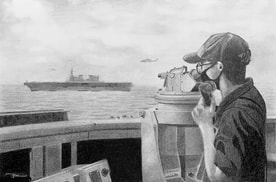
On Watch
10x15 Graphite on Illustration Board
Lt. j.g. Searra Sandlin peers through a telescopic alidade as he stands watch on the bridge wing of the guided-missile destroyer USS John S. McCain (DDG 56.) His ship is
conducting integrated maritime security operations with the JS Hyūga (DDH 181,) a Japan Maritime Self-Defense Force helicopter destroyer, and the French navy’s FS Émeraude (S-604,) a nuclear-powered submarine in the Philippine Sea on 17 December
2020. Official photo used as reference taken by Mass Communication Specialist 2nd Class Markus Castaneda.
10x15 Graphite on Illustration Board
Lt. j.g. Searra Sandlin peers through a telescopic alidade as he stands watch on the bridge wing of the guided-missile destroyer USS John S. McCain (DDG 56.) His ship is
conducting integrated maritime security operations with the JS Hyūga (DDH 181,) a Japan Maritime Self-Defense Force helicopter destroyer, and the French navy’s FS Émeraude (S-604,) a nuclear-powered submarine in the Philippine Sea on 17 December
2020. Official photo used as reference taken by Mass Communication Specialist 2nd Class Markus Castaneda.
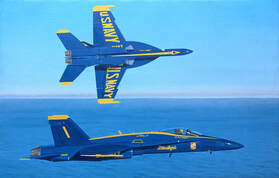
Blue Angels Retire Legacy Hornets
18x28 Oil on Linen
The US Navy conducted its final flight of the F/A-18 A/B/C/D “Legacy” Hornets on 4 November 2020 with the official transition of the Blue Angels to the F/A-18 E/F Super Hornet platform. The “legacy” jets concluded 34 years of service with the 30-minute flight that took place around the Naval Air Station in Pensacola and lasted about 30 minutes. For the Blue Angels, this flight was the last of the 2020 season with the 2021
show season being their first year flying the Super Hornet platform. It will also be the 75th anniversary of the team. Official photo used as reference taken by Mass Communication Specialist 2nd Class Christopher Gordon.
18x28 Oil on Linen
The US Navy conducted its final flight of the F/A-18 A/B/C/D “Legacy” Hornets on 4 November 2020 with the official transition of the Blue Angels to the F/A-18 E/F Super Hornet platform. The “legacy” jets concluded 34 years of service with the 30-minute flight that took place around the Naval Air Station in Pensacola and lasted about 30 minutes. For the Blue Angels, this flight was the last of the 2020 season with the 2021
show season being their first year flying the Super Hornet platform. It will also be the 75th anniversary of the team. Official photo used as reference taken by Mass Communication Specialist 2nd Class Christopher Gordon.
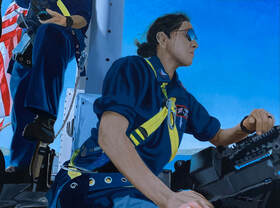
USS Florida’s TM2 Drake
16x20 Oil on Linen
Depicted is TM2 Drake of the Ohio Class SSGN-728 USS Florida. A Torpedoman’s Mate is responsible for the operation, routine care and repair of submarine weapons systems. Here she is on the bridge of the USS Florida as it conducts routine navigation and watch procedures on the surface of the Mediterranean Sea in the fall of 2019. The USS Florida is the first submarine and the sixth United States Navy ship to bear the name of the state. It was the second submarine to complete the conversion from a ballistic-missile submarine to a guided-missile submarine.
16x20 Oil on Linen
Depicted is TM2 Drake of the Ohio Class SSGN-728 USS Florida. A Torpedoman’s Mate is responsible for the operation, routine care and repair of submarine weapons systems. Here she is on the bridge of the USS Florida as it conducts routine navigation and watch procedures on the surface of the Mediterranean Sea in the fall of 2019. The USS Florida is the first submarine and the sixth United States Navy ship to bear the name of the state. It was the second submarine to complete the conversion from a ballistic-missile submarine to a guided-missile submarine.
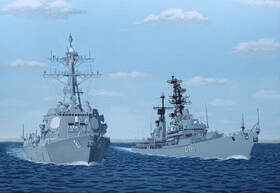
“We Stand by You”
21x30 Oil on Linen
After the terrorist attack on the United States on September 11, 2001, USS Churchill, an Arleigh Burke-class destroyer commissioned the previous May, was recalled from a port call in Portsmouth, England along with the destroyer USS Gonzalez. Also recalled while enjoying a port call at the same time was the German destroyer Lutjens. The Churchill and Lutjens steamed out of Portsmouth around the same time, but before the two vessels would turn toward their respective home ports, the Lutjens contacted the Churchill wishing to pass closely to port to wish the Americans well on their voyage home. As tradition dictated, the crew of the Churchill “manned its rails” and as the Lutjens caught up with her with the German flag at half-mast and the US flag flying above it, her rails were manned as well. Both crews rendered honors with salutes then hand waves when a banner unfurled on the Lutjens that read “We Stand by You.” It was a simple message, but it spoke volumes to the Americans.
21x30 Oil on Linen
After the terrorist attack on the United States on September 11, 2001, USS Churchill, an Arleigh Burke-class destroyer commissioned the previous May, was recalled from a port call in Portsmouth, England along with the destroyer USS Gonzalez. Also recalled while enjoying a port call at the same time was the German destroyer Lutjens. The Churchill and Lutjens steamed out of Portsmouth around the same time, but before the two vessels would turn toward their respective home ports, the Lutjens contacted the Churchill wishing to pass closely to port to wish the Americans well on their voyage home. As tradition dictated, the crew of the Churchill “manned its rails” and as the Lutjens caught up with her with the German flag at half-mast and the US flag flying above it, her rails were manned as well. Both crews rendered honors with salutes then hand waves when a banner unfurled on the Lutjens that read “We Stand by You.” It was a simple message, but it spoke volumes to the Americans.
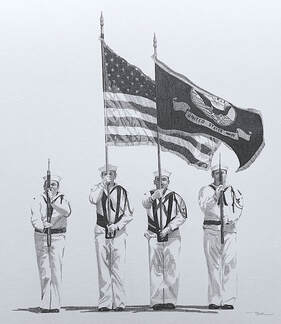
Navy Color Guard
15.75x14 Graphite on Illustration Board
Each military branch has its own Honor Guard. Most state National Guard units have a ceremonial guard as well. The official Honor Guard of every branch is based in Washington, D.C., though nearly every military installation will have its own Honor Guard for local ceremonies and events. Established in 1931, the United States Navy Ceremonial Guard is the official ceremonial unit of the Navy. The Navy Ceremonial Guard's primary mission is to represent the service in Presidential, Joint Armed Services, Navy, and public ceremonies in the nation's capital. The Navy Ceremonial Guard also serves as the funeral escort and conducts all services for Navy personnel buried in Arlington National Cemetery.
15.75x14 Graphite on Illustration Board
Each military branch has its own Honor Guard. Most state National Guard units have a ceremonial guard as well. The official Honor Guard of every branch is based in Washington, D.C., though nearly every military installation will have its own Honor Guard for local ceremonies and events. Established in 1931, the United States Navy Ceremonial Guard is the official ceremonial unit of the Navy. The Navy Ceremonial Guard's primary mission is to represent the service in Presidential, Joint Armed Services, Navy, and public ceremonies in the nation's capital. The Navy Ceremonial Guard also serves as the funeral escort and conducts all services for Navy personnel buried in Arlington National Cemetery.
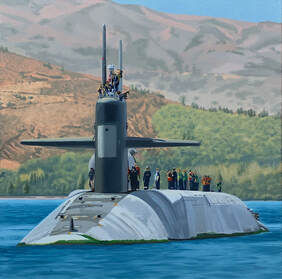
Some Sun Before Diving
20x20 Oil on Canvas
In November 2019 the nuclear submarine USS Florida is surfaced in the eastern Mediterranean Sea while conducting training and preparing for a new specialized mission. Three of the seven crewmembers on the bridge are female following a policy change made by the US Navy nine years earlier allowing females to serve on submarines. While surfaced it is also a fairly rare opportunity for submariners to get some sun during a deployment.
20x20 Oil on Canvas
In November 2019 the nuclear submarine USS Florida is surfaced in the eastern Mediterranean Sea while conducting training and preparing for a new specialized mission. Three of the seven crewmembers on the bridge are female following a policy change made by the US Navy nine years earlier allowing females to serve on submarines. While surfaced it is also a fairly rare opportunity for submariners to get some sun during a deployment.
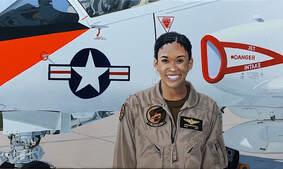
A Navy ‘First’
18x30 Oil on Linen
On 31 July 2020 Lt JG Madeline Swegle graduated with 25 of her classmates at NAS Kingsville, Texas and became the first known black, female tactical air pilot to serve in the US Navy. She received her gold wings having successfully completing advanced training in the aircraft behind her, the T-45C Goshawk. Lt Swegle will next report to the “Vikings” of Electronic Attack Squadron 129 at NAS Whidbey Island in Washington
State to begin training as an EA-18G Growler pilot. VAQ-129 trains new naval aviators, naval flight officers, and naval aircrew in electronic warfare tactics, techniques, and procedures in advance of their fleet assignments.
18x30 Oil on Linen
On 31 July 2020 Lt JG Madeline Swegle graduated with 25 of her classmates at NAS Kingsville, Texas and became the first known black, female tactical air pilot to serve in the US Navy. She received her gold wings having successfully completing advanced training in the aircraft behind her, the T-45C Goshawk. Lt Swegle will next report to the “Vikings” of Electronic Attack Squadron 129 at NAS Whidbey Island in Washington
State to begin training as an EA-18G Growler pilot. VAQ-129 trains new naval aviators, naval flight officers, and naval aircrew in electronic warfare tactics, techniques, and procedures in advance of their fleet assignments.
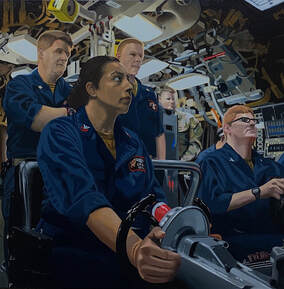
At the Controls
20x20 Oil on Canvas
In 2010 a major policy change was adopted by the US Navy that allowed female sailors to serve on submarines. Here, handling the helm on the USS Florida is a Petty Officer First Class. Her job is to control the rudder, and the sail planes. The sailor to her left is the outboard watch stander, who he controls the rear planes. The two, acting together, maintain the ordered direction, roll, pitch, depth of the sub as ordered by the Dive Officer of the watch, standing between and behind them.
20x20 Oil on Canvas
In 2010 a major policy change was adopted by the US Navy that allowed female sailors to serve on submarines. Here, handling the helm on the USS Florida is a Petty Officer First Class. Her job is to control the rudder, and the sail planes. The sailor to her left is the outboard watch stander, who he controls the rear planes. The two, acting together, maintain the ordered direction, roll, pitch, depth of the sub as ordered by the Dive Officer of the watch, standing between and behind them.
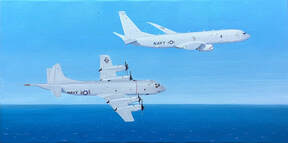
Baton Passes to Poseidon
15x30 Oil on Linen
On 14 May 2020 VP-40, based at NAS Whidbey Island, Washington completed the transition from the propeller-driven P-3 Orion to the new P-8 Poseidon when its last
P-3C, aircraft number 162776, was flown from Whidbey Island to NAS Pensacola. VP-40 was the last active duty patrol squadron flying the Orion, an anti-submarine warfare champion for nearly sixty years. All P-3 squadrons have now transitioned to the P-8, which is a Boeing 737-800ERX modified for the US Navy and several allied nations. Two Naval Reserve squadrons, VP-62 at NAS Jacksonville and VP-69 at NAS Whidbey Island will continue to fly the Orion until 2023, and Air Test & Eval Squadron 30 at NAS Pt. Mugu will continue to fly the Orion past 2023.
15x30 Oil on Linen
On 14 May 2020 VP-40, based at NAS Whidbey Island, Washington completed the transition from the propeller-driven P-3 Orion to the new P-8 Poseidon when its last
P-3C, aircraft number 162776, was flown from Whidbey Island to NAS Pensacola. VP-40 was the last active duty patrol squadron flying the Orion, an anti-submarine warfare champion for nearly sixty years. All P-3 squadrons have now transitioned to the P-8, which is a Boeing 737-800ERX modified for the US Navy and several allied nations. Two Naval Reserve squadrons, VP-62 at NAS Jacksonville and VP-69 at NAS Whidbey Island will continue to fly the Orion until 2023, and Air Test & Eval Squadron 30 at NAS Pt. Mugu will continue to fly the Orion past 2023.
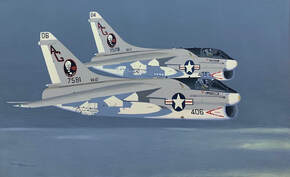
Corsairs
15x24 Oil on Linen
In the fall of 1973 VA-12, “The Clinchers,” was flying A-7 Corsair II aircraft as part of Carrier Air Wing 7 aboard the USS Independence (CV62.) The cruise was to the Mediterranean Sea amid increased tensions in the area surrounding the Yom Kippur War between Israel and its Arab neighbors. Here two A-7s return from a mission, catching a brief burst of sunlight before descending into the undercast that separates
them from their carrier home. The wingman has pulled into fingertip position to be able to maintain the formation until through the clouds.
15x24 Oil on Linen
In the fall of 1973 VA-12, “The Clinchers,” was flying A-7 Corsair II aircraft as part of Carrier Air Wing 7 aboard the USS Independence (CV62.) The cruise was to the Mediterranean Sea amid increased tensions in the area surrounding the Yom Kippur War between Israel and its Arab neighbors. Here two A-7s return from a mission, catching a brief burst of sunlight before descending into the undercast that separates
them from their carrier home. The wingman has pulled into fingertip position to be able to maintain the formation until through the clouds.
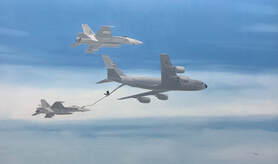
Fill ‘er Up
18x30 Oil on Linen
Two Navy F/A-18 Hornets of VFA-143 (Fighter Attack Squadron 143,) the famous “Pukin’ Dogs," assigned to the USS Abraham Lincoln are topped off by an Air Force KC-135 tanker from an undisclosed Air Force Base. Being able to refuel very quickly in flight allows the Hornet to carry more ordinance at take-off and to extend its range or loiter time, limited only by the endurance of the pilot. Aerial refueling has come a long way
since 1923 when its first trials of manually extending the equivalent of a garden hose from a hand-held tank in one bi-plane to a second bi-plane by removing the gas cap and inserting the hose like normal into the gas tank.
18x30 Oil on Linen
Two Navy F/A-18 Hornets of VFA-143 (Fighter Attack Squadron 143,) the famous “Pukin’ Dogs," assigned to the USS Abraham Lincoln are topped off by an Air Force KC-135 tanker from an undisclosed Air Force Base. Being able to refuel very quickly in flight allows the Hornet to carry more ordinance at take-off and to extend its range or loiter time, limited only by the endurance of the pilot. Aerial refueling has come a long way
since 1923 when its first trials of manually extending the equivalent of a garden hose from a hand-held tank in one bi-plane to a second bi-plane by removing the gas cap and inserting the hose like normal into the gas tank.
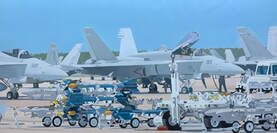
Prepping for Flight
18x36 Oil on Canvas
Naval Air Staton Oceana is the U.S. Navy F/A-18 Hornet and Super Hornet fleet’s east coast home, accomplishing 219,000 training operations each year. With this volume of training the flight line is kept very busy. Just some of the things required of the ground
crews to get an F/A-18 ready for a training flight include fueling, topping off hydraulic fluid and oxygen, testing avionics and other systems, practice munitions, strut and tire pressure, making sure all fasteners are in place and closed, ensuring the engine intakes are clear, removing any foreign objects from the cockpit, removing dead bugs from the windshield and much more. As depicted here, in July of 2018 the base’s location in Virginia Beach was experiencing the usual very hot and humid weather, making for very uncomfortable working conditions.
18x36 Oil on Canvas
Naval Air Staton Oceana is the U.S. Navy F/A-18 Hornet and Super Hornet fleet’s east coast home, accomplishing 219,000 training operations each year. With this volume of training the flight line is kept very busy. Just some of the things required of the ground
crews to get an F/A-18 ready for a training flight include fueling, topping off hydraulic fluid and oxygen, testing avionics and other systems, practice munitions, strut and tire pressure, making sure all fasteners are in place and closed, ensuring the engine intakes are clear, removing any foreign objects from the cockpit, removing dead bugs from the windshield and much more. As depicted here, in July of 2018 the base’s location in Virginia Beach was experiencing the usual very hot and humid weather, making for very uncomfortable working conditions.
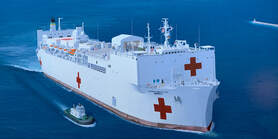
Mercy to Los Angeles
18x36 Oil on Linen
In March of 2020 President Trump ordered the US Navy’s two hospital ships to America’s two largest cities. The USNS Comfort was sent to New York City and the USNS Mercy was sent to Los Angeles. On Friday 27 March the Mercy docked at the Cruise Terminal of Port of Los Angeles to aid in hospital relief during the COVID-19
virus worldwide pandemic by adding a highly-trained Navy medical staff, twelve operating rooms, a laboratory and pharmacy, and 1000 beds to relieve area hospitals of non-COVID-19 patients while the hospitals handled mainly virus cases. After a few days area hospitals were vastly expanding their ICU capabilities and releif wasn’t critical, so some of the medical staff of USNS Mercy was deployed ashore to area skilled care retirement facilities to help fill a critical need where most of the new virus cases are being identified.
18x36 Oil on Linen
In March of 2020 President Trump ordered the US Navy’s two hospital ships to America’s two largest cities. The USNS Comfort was sent to New York City and the USNS Mercy was sent to Los Angeles. On Friday 27 March the Mercy docked at the Cruise Terminal of Port of Los Angeles to aid in hospital relief during the COVID-19
virus worldwide pandemic by adding a highly-trained Navy medical staff, twelve operating rooms, a laboratory and pharmacy, and 1000 beds to relieve area hospitals of non-COVID-19 patients while the hospitals handled mainly virus cases. After a few days area hospitals were vastly expanding their ICU capabilities and releif wasn’t critical, so some of the medical staff of USNS Mercy was deployed ashore to area skilled care retirement facilities to help fill a critical need where most of the new virus cases are being identified.

Comfort to New York City
16x48 Oil on Linen
In March of 2020 President Trump ordered the US Navy’s two hospital ships to America’s two largest cities. The USNS Comfort was sent to New York City and the
USNS Mercy was sent to Los Angeles. On Monday 30 March the USNS Comfort arrived in New York Harbor for the first time since the terrorist attacks in September, 2001 to aid in hospital relief during the COVID-19 virus worldwide pandemic. The ship was docked at Pier 90 on the Hudson River in mid-town Manhattan and adding a highly-trained Navy medical staff, twelve operating rooms, a laboratory and pharmacy, and 1000 beds to releive area hospitals of non-COVID-19 patients while the hospitals handled mainly virus cases. After a few days area hospitals were vastly expanding their ICU capabilities and relief wasn’t critical, so the medical staff of USNS Comfort also started handling cases of the virus as well.
16x48 Oil on Linen
In March of 2020 President Trump ordered the US Navy’s two hospital ships to America’s two largest cities. The USNS Comfort was sent to New York City and the
USNS Mercy was sent to Los Angeles. On Monday 30 March the USNS Comfort arrived in New York Harbor for the first time since the terrorist attacks in September, 2001 to aid in hospital relief during the COVID-19 virus worldwide pandemic. The ship was docked at Pier 90 on the Hudson River in mid-town Manhattan and adding a highly-trained Navy medical staff, twelve operating rooms, a laboratory and pharmacy, and 1000 beds to releive area hospitals of non-COVID-19 patients while the hospitals handled mainly virus cases. After a few days area hospitals were vastly expanding their ICU capabilities and relief wasn’t critical, so the medical staff of USNS Comfort also started handling cases of the virus as well.
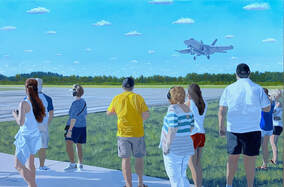
Family Day at NAS Oceana
18x27 Oil on Linen
As Navy pilots near the end of their advanced F-18 training at NAS Oceana in Norfolk, Virginia a “Family Day” is organized to allow friends and family of the pilots to see first hand some of the activities and facilities in which their pilot have trained during the lengthy time they have been there. Included in the trainee-led tour is the maintenance hangar, flight line, squadron briefing for the day’s sorties, and depicted here, a trip to Navy Auxiliary Landing Field (NALF) Fentress located roughly twenty miles away from
NAS Oceana. The purpose of an NALF is to reduce congestion in the landing pattern at the main base when to focus of the mission is on practicing flying the “ball” for pinpoint landings simulating carrier landings. The families are allowed to get right up to the runway at the approach end to watch their pilots practice simulated carrier landings. In about four weeks the pilots will graduate and be assigned to a carrier squadron in the fleet.
18x27 Oil on Linen
As Navy pilots near the end of their advanced F-18 training at NAS Oceana in Norfolk, Virginia a “Family Day” is organized to allow friends and family of the pilots to see first hand some of the activities and facilities in which their pilot have trained during the lengthy time they have been there. Included in the trainee-led tour is the maintenance hangar, flight line, squadron briefing for the day’s sorties, and depicted here, a trip to Navy Auxiliary Landing Field (NALF) Fentress located roughly twenty miles away from
NAS Oceana. The purpose of an NALF is to reduce congestion in the landing pattern at the main base when to focus of the mission is on practicing flying the “ball” for pinpoint landings simulating carrier landings. The families are allowed to get right up to the runway at the approach end to watch their pilots practice simulated carrier landings. In about four weeks the pilots will graduate and be assigned to a carrier squadron in the fleet.
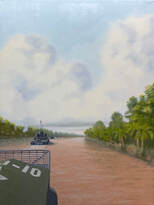
Riverine Convoy
24x18 Oil on Canvas
In mid-October of 1968 multiple divisions of the US Navy’s Mobile Riverine Task Force 117, River Assault Squadron 9 (part of what had earlier been formed as the “Brown Water Navy,) traveled north on the Ham Luong River just upstream from the city of Ben Tre in the Mekong River Delta with US Army forces aboard. Most of the vessels depicted were called “Tango Boats,” or Armored Troop Carriers (ATCs.) These boats were used by the US Navy to transport and provide cover fire during insertion and extraction forces of the Army’s Ninth Infantry Division according to their military objectives in the
delta. Waterways served as the “highways” of this region, and the US Navy was tasked with keeping them open for friendly military and civilian economic use while at the same time interdicting the transport of enemy forces and materials.
24x18 Oil on Canvas
In mid-October of 1968 multiple divisions of the US Navy’s Mobile Riverine Task Force 117, River Assault Squadron 9 (part of what had earlier been formed as the “Brown Water Navy,) traveled north on the Ham Luong River just upstream from the city of Ben Tre in the Mekong River Delta with US Army forces aboard. Most of the vessels depicted were called “Tango Boats,” or Armored Troop Carriers (ATCs.) These boats were used by the US Navy to transport and provide cover fire during insertion and extraction forces of the Army’s Ninth Infantry Division according to their military objectives in the
delta. Waterways served as the “highways” of this region, and the US Navy was tasked with keeping them open for friendly military and civilian economic use while at the same time interdicting the transport of enemy forces and materials.

